Análisis del Padlet en el proceso educativo sobre el ciclo de las rocas a través de la Ciencia de Datos
Analysis of Padlet in the educational process on the rock cycle through Data Science
Ricardo-Adán Salas-Rueda
National School of Earth Sciences, National Autonomous University of Mexico, Mexico City, Mexico
https://orcid.org/0000-0002-4188-4610
Arturo-Efrén Cabrera-Rodríguez
Faculty of Philosophy and Letters, National Autonomous University of Mexico, Mexico City, Mexico
https://orcid.org/0009-0004-0528-6383
arturoefren.cabrera@bachilleres.edu.mx
Eduardo Domínguez-Herrera
Faculty of Philosophy and Letters, National Autonomous University of Mexico, Mexico City, Mexico
https://orcid.org/0000-0002-1524-218X
RESUMEN
El objetivo general de este estudio mixto es analizar el uso del muro virtual llamado Padlet en el proceso de enseñanza-aprendizaje sobre el ciclo de las rocas a través de la Ciencia de datos. El maestro del curso de Geografía incorporó el Padlet fuera del salón de clases para facilitar el aprendizaje sobre el ciclo de las rocas y propiciar el intercambio de ideas en las sesiones presenciales bajo la estrategia del Aula invertida. Los participantes son 114 estudiantes de una preparatoria pública de la Ciudad de México. Los resultados del algoritmo regresión lineal indican que la incorporación del muro virtual impactó positivamente la revisión de las actividades y los recursos digitales educativos sobre el ciclo de las rocas. El algoritmo árbol de decisión construyó dos modelos sobre el uso del Padlet. En conclusión, los muros virtuales están cambiando la forma de organizar el proceso de enseñanza-aprendizaje sobre la Geografía.
PALABRAS CLAVE
Enseñanza; muro virtual; aula invertida; Geografía; Padlet.
ABSTRACT
The general aim of this mixed study is to analyze the use of the virtual wall called Padlet in the teaching-learning process on the rock cycle through Data Science (linear regression and decision tree algorithms). The teacher of the Geography course incorporated Padlet outside the classroom to facilitate the learning and promote the exchange of the ideas in the face-to-face sessions under Flipped Classroom. The participants are 114 students from a public high school located in Mexico City. The results of the linear regression algorithm indicate that the incorporation of Padlet positively impacted the review of educational digital resources and activities on the rock cycle. The decision tree algorithm built two models considering the characteristics of the students. This mixed research recommends the use of Padlet because this tool offers flexibility of time and space. In conclusion, virtual walls are changing the way to organize the teaching-learning process about Geography.
Teaching; virtual wall flipped classroom; Geography; Padlet.
1. INTRODUCTION
Currently, virtual walls along with educational strategies such as Flipped Classroom are causing the implementation of new environments intended for learning and teaching on the Internet (Colton, 2020; De-Witt & Koh, 2020; Prabhat, 2022). For example, Padlet is a virtual wall used in the educational context because students access the contents and digital resources of the courses at any time of the day (Getenet & Tualaulelei, 2023; Park et al., 2023; Rosenbaum et al., 2021).
In the educational institutions, virtual walls are used to organize individual and collaborative activities (De-Witt & Koh, 2020; Getenet & Tualaulelei, 2023; Prabhat, 2022). In particular, these communication tools promote the debate of the topics in the classroom through the publication of the comments (Getenet & Tualaulelei, 2023; Prabhat, 2022; Rosenbaum et al., 2021). Furthermore, students use virtual walls to share the products developed such as multimedia resources and images during the face-to-face sessions with the purpose of initiating the exchange of ideas (Getenet & Tualaulelei, 2023; Park et al., 2023; Prabhat, 2022).
Outside the classroom, virtual walls play a fundamental role in the educational field to promote the learning and autonomy (Colton, 2020; Johnson et al., 2023; Rosenbaum et al., 2021). For example, Padlet allows that student consult the school contents such as digital presentations, videos, infographics, audios, and websites before the classes in order to learn in a fun way the topics of the courses (Johnson et al., 2023; Park et al., 2023; Rosenbaum et al., 2021). Even, virtual walls are a technological means that facilitate the delivery of laboratory practices and assignments from anywhere (Park et al., 2023; Prabhat, 2022; Rosenbaum et al., 2021).
In the field of Physics, the virtual wall designed by the Institute of Applied Sciences and Technology facilitated the dissemination of messages and images about the Doppler effect at the upper secondary level (Salas-Rueda et al., 2022). Likewise, this virtual wall facilitated the learning about climate change through the information and images (Salas-Rueda et al., 2021).
The great advantage of Padlet over other virtual walls is the ease of distribution and visualization of various educational resources such as videos, audios, interactive infographics, and web links (Getenet & Tualaulelei, 2023; Johnson et al., 2023; Park et al., 2023).
Educational strategies such as Flipped Classroom are necessary to carry out a successful implementation of Information and Communication Technology (ICT) in high schools and universities (Chimmalee & Anupan, 2023; Li et al., 2023; Tang et al., 2023). In fact, Flipped Classroom facilitates the realization of the school activities before the face-to-face or virtual sessions, in the classroom and after the classes (Keskin, 2023; Hebebci & Ozer, 2023; Hsieh & Maritz, 2023). Furthermore, this educational strategy favors the creation of environments where the student is motivated to learn (Aidoo et al., 2022; Alahmadi & Saleem, 2022; Hsieh & Maritz, 2023; Nasongkhla & Sujiva, 2022).
In a public high school located in Mexico City, the teacher of the Geography course incorporated Padlet outside the classroom to facilitate the learning on the rock cycle and promote the exchange of the ideas in the face-to-face sessions under the Flipped Classroom strategy.
The general aim of this mixed study is to analyze the use of Padlet in the teaching-learning process on the rock cycle for the review of educational digital resources and activities during the Geography course through Data Science (linear regression and decision tree algorithms). The research questions are:
•How does the incorporation of Padlet influence the review of educational digital resources and activities on the rock cycle during the Geography course considering the linear regression algorithm?
•What are the models on the use of Padlet and characteristics of the students considering the decision tree algorithm?
•What is the opinion of the participants about the use of this virtual wall in the educational process on the rock cycle during the Geography course?
2. LITERATURE REVIEW
2.1. Virtual wall in the educational context
Educators use Padlet to encourage the active role and facilitate the learning in the face-to-face and remote modalities (Colton, 2020; Getenet & Tualaulelei, 2023; Johnson et al., 2023; Ling et al., 2023; Park et al., 2023). In fact, the use of this virtual wall creates fun and entertaining spaces (Colton, 2020; Ling et al., 2023; Park et al., 2023). Padlet has even been used at all educational levels which has allowed that students are the fundamental element of the teaching-learning process (Getenet & Tualaulelei, 2023; Johnson et al., 2023; Ling et al., 2023; Park et al., 2023).
In the Geography course, the use of Padlet encouraged the active role (Park et al., 2023). This virtual wall facilitated the learning about Geographic Information Systems through the realization of the debates and distribution of the school contents (Park et al., 2023). In fact, Padlet favored the collaborative work and increased the motivation during the review of videos about Geographic Information Systems (Park et al., 2023).
In the Chemistry course, Padlet encouraged the interaction through the publication of the comments outside and inside the classroom (Andrews et al., 2020). In the face-to-face classes, the students used this virtual wall to collaboratively work on biochemistry topics (Andrews et al., 2020).
On the other hand, Padlet is a tool that facilitates access to information and multimedia resources from anywhere (Hursen, 2021). According to Hursen (2021), this web application was used to train the teachers on topics related to evaluation and rubrics.
At a university in Australia, the teacher of the Art Design course sought to create a learning environment with the support of Padlet to reduce the stress of the students (Johnson et al., 2023). This teacher used the Moodle platform to organize and disseminate the debates held on this virtual wall (Johnson et al., 2023). By sharing the images and text about Art Design on Padlet, the students increased their participation in relation to the results obtained from the groups during the previous semesters (Johnson et al., 2023).
Getenet and Tualaulelei (2023) designed a new virtual environment to facilitate the learning at the higher educational level through the dissemination and discussion of the information on Padlet, the creation of the videos on the Panopto application, and the sharing of the files on the Google Docs. With the support of these technological tools, the aspect of the collaborative work improved substantially during the realization of the educational process (Getenet & Tualaulelei, 2023).
Similarly, Colton (2020) proposes the creation of educational virtual environments through Padlet for the dissemination of the resources, Instagram for the communication, and FlipGrid for the creation of the videos. In the Foreign Language course, these technological advances improved the assimilation of the knowledge, encouraged the active role, and developed the skills related to the English language (Colton, 2020).
In the Republic of Singapore, the students at the primary school used Padlet to post the comments (Ling et al., 2023). The incorporation of this virtual wall at the basic educational level facilitated the development of writing skills and increased the motivation (Ling et al., 2023).
Finally, virtual walls are support tools for the educational field (Johnson et al., 2023; Ling et al., 2023; Park et al., 2023). In particular, Padlet facilitated the learning in the courses of Geography (Park et al., 2023), Education (Hursen, 2021), Art Design (Johnson et al., 2023), Chemistry (Andrews et al., 2020) and Foreign Language (Colton, 2020).
3. MATERIAL AND METHODS
The particular aims of this quantitative and qualitative research are (1) analyze the incorporation of Padlet for the review of educational digital resources and activities on the rock cycle during the Geography course through the linear regression algorithm, (2) build the models on this wall virtual and the characteristics of the participants through the decision tree algorithm, and (3) analyze the opinion of the students about the use of Padlet in the teaching-learning process on the rock cycle during the Geography course.
In this mixed study, the sample is non-probabilistic. The participants are 114 students from a public high school located in Mexico City who took the Geography course during the 2023 school year. The scope of this work is descriptive, causal, and correlational.
3.1. Procedure
The teacher of the Geography course incorporated Padlet outside the classroom in order to facilitate the learning on the rock cycle and encourage the exchange of the ideas (assertive communication) in the face-to-face sessions. Under the Flipped Classroom strategy, the students of the Geography course assumed an active role from home, in the classroom and after the face-to-face sessions (See Figure 1).
Figure 1. Flipped classroom strategy in the Geography course.

Figure 2 shows an example about the use of Padlet in the teaching-learning process on the rock cycle.
Figure 2. Use of Padlet in the teaching-learning process on the rock cycle
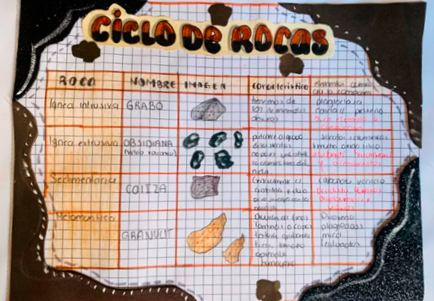
The research hypotheses about the use of Padlet in the teaching-learning process on the rock cycle are:
•Hypothesis 1: The incorporation of the virtual wall positively impacts the review of the educational activities on the rock cycle
•Hypothesis 2: The incorporation of the virtual wall positively impacts the review of the educational digital resources on the rock cycle
Through the decision tree algorithm, this mixed research built the following models about the use of Padlet in the Geography course:
•Model 1 about the virtual wall (Padlet), review of the educational activities, and characteristics of the students (sex and age)
•Model 2 about the virtual wall (Padlet), review of the educational digital resources, and characteristics of the students (sex and age)
3.2.Data collection.
Data collection was carried out in the Geography course from a public high school located in Mexico City during the 2023 school year through a digital questionnaire (See Table 1). This measurement instrument consists of 3 closed questions about the use of Padlet, 2 closed questions about the characteristics of the students and 1 open question about the use of this virtual wall in the Geography course.
Table 1. Digital questionnaire about Padlet.
|
No. |
Variable |
Dimension |
Question |
Answer |
n |
% |
|
1 |
Virtual wall |
Assimilation of knowledge |
1. The incorporation of the virtual wall facilitates the assimilation of knowledge in the Geography course |
|||
|
Very much (1) |
49 |
42.98 % |
||||
|
Much (2) |
52 |
45.61 % |
||||
|
Little (3) |
12 |
10.53 % |
||||
|
Very little (4) |
1 |
0.88 % |
||||
|
Review of the educational activities |
2. The virtual wall facilitates the review of the educational activities on the rock cycle |
|||||
|
Very much (1) |
53 |
46.49 % |
||||
|
Much (2) |
55 |
48.25 % |
||||
|
Little (3) |
6 |
5.26 % |
||||
|
Very little (4) |
0 |
0.00 % |
||||
|
Review of the educational digital resources |
3. The virtual wall facilitates the review of the educational digital resources on the rock cycle |
|||||
|
Very much (1) |
51 |
44.74 % |
||||
|
Much (2) |
55 |
48.25 % |
||||
|
Little (3) |
8 |
7.02 % |
||||
|
Very little (4) |
0 |
0.00 % |
||||
|
2 |
Opinion |
Padlet |
4. Does the incorporation of the virtual wall favor the assimilation of knowledge in the Geography course? |
Open |
– |
– |
|
3 |
Characteristics |
Sex |
5. What is your sex? |
|||
|
Man |
38 |
33.33 % |
||||
|
Woman |
76 |
66.67 % |
||||
|
Age |
6. What is your age? |
|||||
|
15 years |
22 |
19.30 % |
||||
|
16 years |
84 |
73.68 % |
||||
|
17 years |
8 |
7.02 % |
Table 2 shows the validation of the questionnaire on the use of Padlet in the Geography course. The values of Load Factor must be greater than 0.500. On the other hand, the values of Cronbach’s Alpha and Composite Reliability must be greater than 0.700. In this study, the measurement instrument meets all validation criteria.
Table 2. Validation of the questionnaire on the virtual wall.
|
Variable |
Dimension |
Load Factor |
Cronbach’s Alpha |
Composite Reliability |
|
Virtual wall. |
Assimilation of knowledge |
0.799 |
0.741 |
0.854 |
|
Review of the educational activities |
0.812 |
|||
|
Review of the educational digital resources |
0.828 |
3.3. Data analysis
This mixed study used the RapidMiner tool to calculate the linear regression and decision tree algorithms. Likewise, the Word Cloud application allowed the analysis of the following open question: “Does the incorporation of the virtual wall favor the assimilation of knowledge in the Geography course?”.
The linear regression algorithm used 40 %, 50 % and 60 % of the sample (training section) to evaluate the research hypotheses about the use of Padlet in the Geography course and 60 %, 50 % and 40 % of the sample (evaluation section) to calculate the squared error of the linear functions (See Figure 3). The linear functions that present the lowest squared error allow forecasting the technological-educational phenomena with greater accuracy. The independent variable is the Assimilation of knowledge through Padlet. The dependent variables are the Review of the activities and educational digital resources on this virtual wall.
Figure 3. Linear regression algorithm.
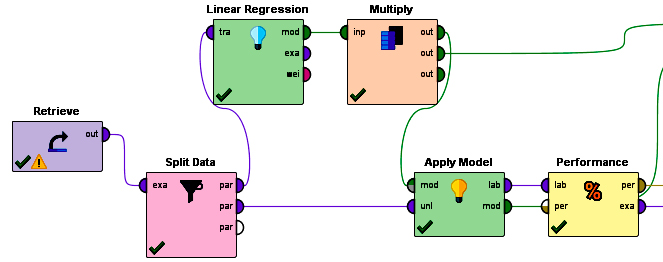
In the decision tree algorithm, the target variables are the Review of activities and educational digital resources on Padlet (see Figure 4). The age and sex of the students allowed building two predictive models on the use of this virtual wall in the Geography course.
Figure 4. Decision tree algorithm.
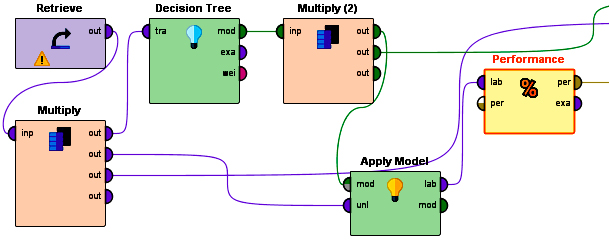
Finally, the Word Cloud application allowed knowing the most significant words about the students’ perception in the Geography course during the use of Padlet in the educational process on the rock cycle.
4. RESULTS.
The incorporation of the virtual wall facilitates very much (n = 49, 42.98 %), much (n = 52, 45.61 %), little (n = 12, 10.53 %) and very little (n = 1, 0.88 %) the assimilation of knowledge in the Geography course. The results of the linear regression algorithm indicate that the incorporation of Padlet positively impacted the review of educational digital resources and activities on the rock cycle (See Table 3).
Table 3. Results of the hypotheses.
|
Hypothesis |
Training section |
Linear regression |
Squared error |
p-value |
Conclusion |
|
H1: Virtual wall → review of the educational activities |
40 % |
y = 0.383x + 0.943 |
0.321 |
0.001 |
Accepted |
|
50 % |
y = 0.410x + 0.906 |
0.363 |
< 0.000 |
Accepted |
|
|
60 % |
y = 0.414x + 0.876 |
0.370 |
< 0.000 |
Accepted |
|
|
H2: Virtual wall → review of the educational digital resources |
40 % |
y = 0.505x + 0.795 |
0.286 |
< 0.000 |
Accepted |
|
50 % |
y = 0.503x + 0.845 |
0.311 |
< 0.000 |
Accepted |
|
|
60 % |
y = 0.467x + 0.891 |
0.295 |
< 0.000 |
Accepted |
Table 4 presents the Pearson correlations on the use of the virtual wall in the Geography course.
Table 4. Pearson correlations on the use of Padlet.
|
Assimilation of knowledge |
Review of the educational activities |
Review of the educational digital resources |
|
|
Assimilation of knowledge |
1 |
– |
– |
|
Review of the educational activities |
0.465 |
1 |
– |
|
Review of the educational digital resources |
0.494 |
0.517 |
1 |
4.1. Review of the educational activities on the rock cycle.
The virtual wall facilitates very much (n = 53, 46.49 %), much (n = 55, 48.25 %) and little (n = 6, 5.26 %) the review of the educational activities on the rock cycle. The results of the linear regression algorithm with 40 % (0.383, p-value = 0.001), 50 % (0.410, p-value < 0.000) and 60 % (0.414, p-value < 0.000) of the sample indicate that hypothesis 1 is accepted. Therefore, the incorporation of the virtual wall positively impacts the review of the educational activities on the rock cycle. With 40 % of the sample (training section), the function y = 0.383x + 0.943 allows predicting these educational phenomena on the use of Padlet with the squared error of 0.321.
Figure 5 shows 7 conditions of the Model 1 on the use of Padlet. For example, if the student considers that the incorporation of Padlet facilitates much the assimilation of knowledge in the Geography course and has an age ≤ 15.5 years then this virtual wall facilitates very much the review of the educational activities on the rock cycle.
Figure 5. Model 1 on the virtual wall in the Geography course.
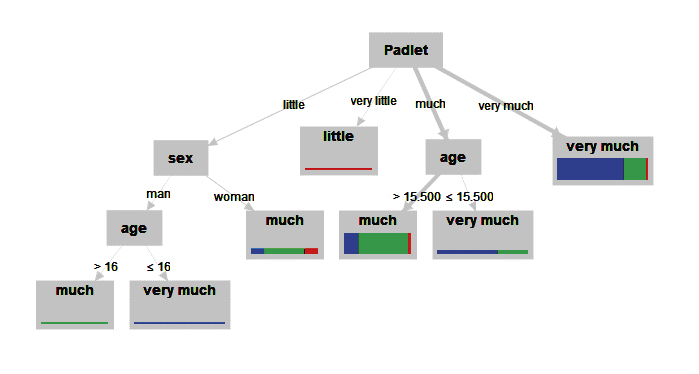
The age determines 4 conditions on the use of Padlet for the review of the educational activities on the rock cycle. For example, if the student considers that the incorporation of Padlet facilitates much the assimilation of knowledge in the Geography course and has an age > 15.5 years then this virtual wall facilitates much the review of the educational activities on the rock cycle.
The sex determines 3 conditions on the use of Padlet for the review of the educational activities on the rock cycle. For example, if the student considers that the incorporation of Padlet facilitates little the assimilation of knowledge in the Geography course and is a woman then this virtual wall facilitates much the review of the educational activities on the rock cycle.
4.2. Review of the educational digital resources on the rock cycle.
The virtual wall facilitates very much (n = 51, 44.74 %), much (n = 55, 48.25 %) and little (n = 8, 7.02 %) the review of the educational digital resources on the rock cycle. The results of the linear regression algorithm with 40 % (0.505, p value < 0.000), 50 % (0.503, p value < 0.000) and 60 % (0.467, p value < 0.000) of the sample indicate that hypothesis 2 is accepted. Therefore, the incorporation of the virtual wall positively impacts the review of the educational digital resources on the rock cycle. With 40 % of the sample (training section), the function y = 0.505x + 0.795 allows predicting these educational phenomena on the use of Padlet with the squared error of 0.286.
Figure 6 shows 7 conditions of the Model 2 on the use of Padlet. For example, if the student considers that the incorporation of Padlet facilitates very much the assimilation of knowledge in the Geography course, has an age > 16.5 years and is a man then this virtual wall facilitates very much the review of the educational digital resources on the rock cycle.
Figure 6. Model 2 on the virtual wall in the Geography course.
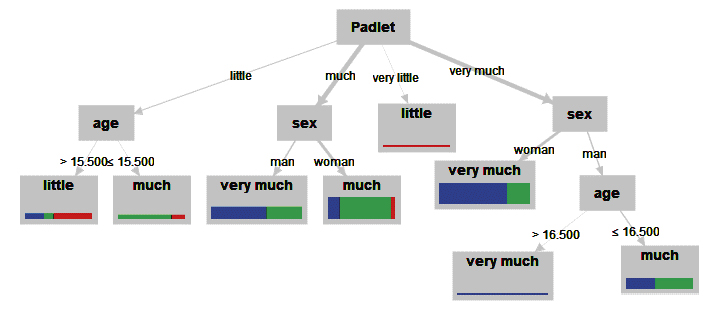
The age determines 4 conditions on the use of Padlet for the review of educational digital resources on the rock cycle. For example, if the student considers that the incorporation of Padlet facilitates very much the assimilation of knowledge in the Geography course, has an age ≤ 16.5 years and is a man then this virtual wall facilitates much the review of the educational digital resources on the rock cycle.
The sex determines 5 conditions on the use of Padlet for the review of educational resources on the rock cycle. For example, if the student considers that the incorporation of Padlet facilitates very much the assimilation of knowledge in the Geography course and is a woman then this virtual wall facilitates very much the review of the educational digital resources on the rock cycle.
4.3. Perception.
According to the participants of the Geography Course, Padlet favored the assimilation of the knowledge.
“It’s easier to understand”
“It is a very good application, and it helps us more to understand”
“It is easier to submit the assignments, understand the topics and have a better understanding of everything”
Also, this virtual wall allowed the review of the topics because this tool is available at any time.
“I feel that it’s easier to learn and if I don’t understand then I can see it again.”
“With the activities, it is a reinforcement of what was explained in the classes”
“With the activities, it provides the feedback on what was seen in the classes”
Likewise, Padlet facilitated the dissemination of the information in the Geography course on the Internet.
“Yes, I review the topics that I see in the classes with the homework”
“Yes, the way of learning and sending the assignments is easier. It helps a lot to understand the school topics”
“Yes, because if I didn’t understand in the classes then Padlet helps me”
One of the benefits related to this virtual wall is the learning.
“We learn more about the topics seen”
“Yes, because it helps to learn every day”
“It helps to understand better”
The incorporation of this virtual wall in the learning process about Geography caused that the students analyze the comments of all.
“I can see the contributions of my colleagues”
“Yes, it helps and allows the free expression of each individual”
“Yes, because I observe what our colleagues think and do, and in this way, I analyze the topic more easily and quickly”
In the Geography course, the ease of the organization and upload of the digital files on Padlet helped the delivery of the activities.
“Yes, I can send the activities and tasks that have been requested in the classes more quickly”
“It is an app to share the tasks and do them”
“Yes, it motivates the performance of the school activities, awakens the interest in acquiring the knowledge, and facilitates the information”
Likewise, the review of the activities on Padlet is a fundamental aspect for the learning process about Geography.
“Yes, because the other classmates share their homework, and I can read them and learn more”
“Yes, because the teacher explains at school and Padlet is an extra help to learn the topics”
“Yes, because through the tasks, I review what I have already seen”
In addition, this virtual wall allowed the interaction and communication with the classmates during the Geography course.
“Yes, it helps to interact with the other students”
“It is much easier to do homework and understand the topic seen in the classes”
“I can review and understand the topics, over and over again with different sources”
Finally, the students of the Geography course used Padlet to share various educational resources.
“Yes, through the Padlet, I can send videos or links, texts and/or images of the school topics”
“Yes, because I can attach videos to understand the topics”
“Yes, because I can read the classmates’ assignments. I understand the topic and complement my knowledge.
Figure 7 shows the word cloud on the use of Padlet in the Geography course where the most frequent words are topics (n = 24), understand (n = 19), better (n =15), class (n =14), tasks (n =14), helps (n =12), teacher (n =12), activities (n = 9), information (n = 9), review (n = 9), way (n = 8), easier (n = 7), Padlet (n = 7) and understanding (n = 7).
Figure 7. Word cloud on the use of Padlet in the Geography course.
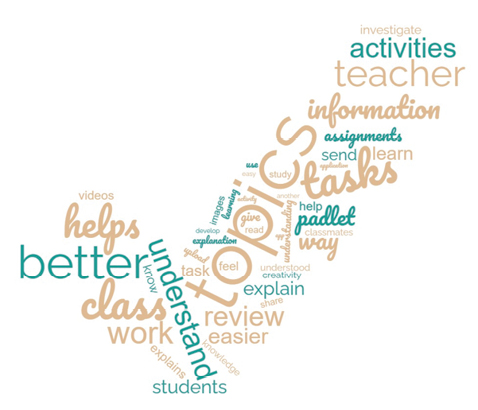
5. DISCUSSION.
Prabhat (2022) and Colton (2020) point out that educational centers rely on virtual walls to promote the learning in a virtual environment. In the Geography course, Padlet helped to review the topics on the rock cycle. In this mixed research, 88.60 % of the participants establish that the incorporation of the virtual wall facilitated very much and much the assimilation of knowledge in the Geography course.
Various researchers (e.g., Getenet & Tualaulelei, 2023; Park et al., 2023; Rosenbaum et al., 2021) explain that Padlet is a favorable tool for the educational field because the student consults the contents of the courses at any time of the day (Getenet & Tualaulelei, 2023; Park et al., 2023; Rosenbaum et al., 2021). In this study, the use of Padlet favored the assimilation of knowledge on the rock cycle. Likewise, this communication tool facilitated the dissemination of the information about Geography on the Internet.
5.1. Review of the educational activities.
Similar to the research of Park et al. (2023), Padlet facilitated the distribution of the school resources and contents in the Geography course. According to respondents, one of the benefits related to this virtual wall is the learning. In particular, 94.74 % of the students establish that the virtual wall facilitated very much and much the review of the educational activities on the rock cycle.
Similar to Ling et al. (2023), virtual walls are technological tools that facilitate the publication of the opinions related to the school issues. In this mixed study, the use of Padlet in the learning process about Geography caused that the students analyze the comments of their classmates.
The results of hypothesis 1 indicate that the incorporation of the virtual wall positively impacted the review of the educational activities on the rock cycle. The function y = 0.383x + 0.943 allows predicting these educational phenomena on the use of Padlet with the squared error of 0.321. Likewise, the Pearson correlation between these variables is 0.465.
On the other hand, the decision tree algorithm identified 7 conditions of the Model 1. In fact, the age determined 4 conditions and sex determined 3 conditions on the use of Padlet for the review of the educational activities on the rock cycle. For example, if the student considers that the incorporation of Padlet facilitates much the assimilation of knowledge in the Geography course and has an age ≤ 15.5 years then this virtual wall facilitates very much the review of the educational activities on the rock cycle.
5.2. Review of the educational digital resources.
As mentioned by Park et al. (2023), Padlet encouraged the active role, collaborative work and review of the videos about the topics of Geography. In this mixed study, the review of the activities on this virtual wall was a primary aspect for the learning. In particular, 92.98 % of the participants establish that the virtual wall facilitates vey much and much the review of the educational digital resources on the rock cycle.
In addition, Colton (2020) explains that virtual walls positively affect the educational process because students assimilate the knowledge, develop the skills, and actively participate. In the Geography course, the use of Padlet allowed interaction and communication with the classmates.
The results of hypothesis 2 indicate that the incorporation of the virtual wall positively impacted the review of the educational digital resources on the rock cycle. The function y = 0.505x + 0.795 allows predicting these educational phenomena on the use of Padlet with the squared error of 0.286. The Pearson correlation between these variables is 0.494.
On the other hand, the decision tree algorithm identified 7 conditions of the Model 2. In fact, the age determined 4 conditions and sex determined 5 conditions on the use of Padlet for the review of the educational digital resources on the rock cycle. For example, if the student considers that the incorporation of Padlet facilitates very much the assimilation of knowledge in the Geography course, has an age > 16.5 years and is a man then this virtual wall facilitates very much the review of the educational digital resources on the rock cycle.
Even Park et al. (2023) points out that Padlet is a virtual educational place where the student is motivated to learn the topics of Geography. According to those surveyed, the ease of use and simplicity of this virtual wall helped the delivery of tasks from anywhere. Finally, the students of the Geography course used Padlet to share and consult various educational resources.
6. CONCLUSION.
In the Geography course, the use of Padlet created a virtual space where the students review the topics, upload the information on the Internet and actively participate by publishing the comments, contents, and activities. In this research, the results of the linear regression algorithm indicate that the incorporation of Padlet positively impacted the review of educational digital resources and activities on the rock cycle.
The decision tree algorithm identified the relationships between the incorporation of Padlet in the Geography course and review of the educational activities in the Model 1 considering the characteristics of the students. Likewise, the Model 2 determined the conditions on the review of the educational digital resources and this virtual wall considering sex and age.
Padlet facilitated the dissemination of the information about Geography on the Internet, allowed the review of the topics at any time and favored the assimilation of the knowledge about the rock cycle. Also, the ease of the organization and upload of the digital files on this virtual wall helped the delivery of the activities.
This mixed research recommends the use of Padlet in the educational context because this tool offers flexibility of time and space during the implementation and realization of the school activities. Furthermore, this virtual wall favored the learning through the analysis of the contents published on the Internet.
In this study, the students of the Geography course used Padlet to share various educational resources. In addition, this virtual wall allowed the interaction and communication between participants during the teaching-learning process about the rock cycle.
The limitations of this mixed study are the dependent variables and educational level of the intervention. Future research can evaluate the use of virtual walls for active role and motivation during the teaching-learning process in high schools and universities. Teachers can even analyze the incorporation of Padlet in various areas of knowledge such as mathematics, engineering, medicine, design, and education.
In conclusion, virtual walls are changing the functions of the teachers during the organization and execution of the activities in the educational institutions. In fact, the use of Padlet facilitated the delivery of tasks, distribution of educational digital resources, consultation of information, collaborative work, communication, interaction and learning on the rock cycle in the Geography course.
DATA ACCESSIBILITY STATEMENT
The data underlying the results presented in this study are available from the Zenodo repository: Salas-Rueda, R.-A., Cabrera-Rodríguez, A.-E., & Domínguez-Herrera, E. (2024). Analysis of Padlet in the educational process on the rock cycle through Data Science [Data set]. Zenodo. [https://doi.org/10.5281/zenodo.13998422]. While the dataset is publicly accessible, users are required to contact the corresponding author.
REFERENCES
, , , , & (2022). Perceptions of Ghanaian Student Teachers on Benefits and Challenges of the Flipped Classroom: A Case Study. Contemporary Educational Technology, 14(4), ep377. https://doi.org/10.30935/cedtech/12163
, & (2022). Implementation of FCM Approach: Challenges Before Teachers and Identification of Gaps. Contemporary Educational Technology, 14(4), ep394. https://doi.org/10.30935/cedtech/12581
, , & (2020). Collaborative Active Learning Activities Promote Deep Learning in a Chemistry-Biochemistry Course. Medical Science Educator, 30, 801-810. https://doi.org/10.1007/s40670-020-00952-x
(2020). Social, Innovative and Deep: Exploring Digital Literacies in a Year 9 English Classroom. Changing English, 27(3), 270-284. https://doi.org/10.1080/1358684X.2020.1766946
, & (2023). The effects of using flipped cloud learning with advancing mathematical thinking approaches on undergraduate students’ mathematical critical thinking. Turkish Online Journal of Distance Education, 24(3), 240-260. https://doi.org/10.17718/tojde.1125894
, & (2020). Promoting knowledge management processes through an interactive virtual wall in a postgraduate business finance course. Journal of Education for Business, 95(4), 255-262. https://doi.org/10.1080/08832323.2019.1635977
, & (2023). Using interactive technologies to enhance student engagement in higher education online learning. Journal of Digital Learning in Teacher Education, 39(4), 220-234. https://doi.org/10.1080/21532974.2023.2244597
, & (2023). Blended learning in higher education: a bibliometric analysis. Turkish Online Journal of Distance Education, 24(3), 93-116. https://doi.org/10.17718/tojde.1143832
, & (2023). Effects of flipped teaching on entrepreneurship professional student’ learning motivation, self-directed learning, and learning outcome. Contemporary Educational Technology, 15(4), ep472. https://doi.org/10.30935/cedtech/13649
(2021). The Effect of Problem-Based Learning Method Supported by Web 2.0 Tools on Academic Achievement and Critical Thinking Skills in Teacher Education. Technology, Knowledge and Learning, 26, 515-533. https://doi.org/10.1007/s10758-020-09458-2
, , , , & (2023). Expanding Creative Communities in the Visual Arts: Using Padlet to Support Student Engagement and Belonging in Stressful Contexts. Art Education, 76(4), 33-39. https://doi.org/10.1080/00043125.2023.2207999
(2023). Implementation of flipped model in efl reading classrooms. Turkish Online Journal of Distance Education, 24(3), 261-279. https://doi.org/10.17718/tojde.1132888
, , & (2023). The link between flipped and active learning: a scoping review. Teaching in Higher Education, 28(8), 1993-2027. https://doi.org/10.1080/13562517.2021.1943655
, , & (2023). Impacts of a socio-cognitive and motivation-and-learning approach on students’ writing with a real audience. Education 3-13, 51(5), 850-861. https://doi.org/10.1080/03004279.2021.2025129
, & (2022). A HyFlex-Flipped Class in Action Learning: A Connectivist MOOC for Creative Problem-Solving. Contemporary Educational Technology, 14(4), ep392. https://doi.org/10.30935/cedtech/12554
, , & (2023). Effectiveness of visual communication and collaboration tools for online GIS teaching: using Padlet and Conceptboard. Journal of Geography in Higher Education, 47(3), 399-410. https://doi.org/10.1080/03098265.2022.2065669
(2022). Online learning and work during the pandemic: update on the legal sector. The Law Teacher, 56(2), 290-293. https://doi.org/10.1080/03069400.2022.2040935
, , & (2021) Let’s not go back to ‘normal’! lessons from COVID-19 for professionals working in childhood disability. Disability and Rehabilitation, 43(7), 1022-1028. https://doi.org/10.1080/09638288.2020.1862925
, , , & (2022). The Collaborative Wall: A Technological Means to Improving the Teaching-Learning Process about Physics. Center for Educational Policy Studies Journal, 12(4), 205-231. https://doi.org/10.26529/cepsj.1167
, , , & (2021). Innovation in the teaching-learning process of global climate change through the collaborative wall. LUMAT: International Journal on Math, Science and Technology Education, 9(1), 256-282. https://doi.org/10.31129/LUMAT.9.1.1471
, , , , , & (2023). Efficiency of flipped classroom with online-based teaching under COVID-19, Interactive Learning Environments, 31(2), 1077-1088. https://doi.org/10.1080/10494820.2020.1817761